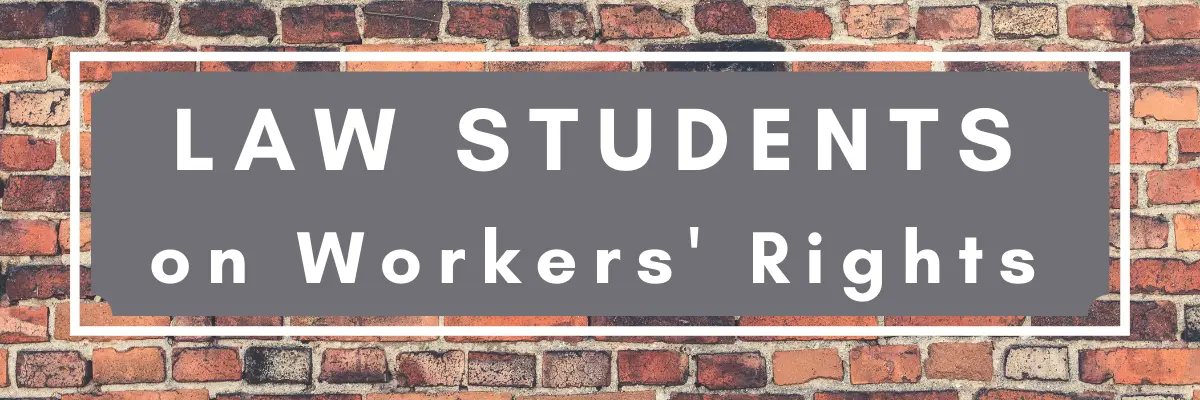
The Court Battles That Shape Workers’ Rights
June 30, 2020
How Arbitration Agreements, Labor Unions, and the Employment At-Will-Doctrine Challenge the Future of Employment Law
By Maxwell Ulin
Law Students on Workers’ Rights Series
The Law Students on Workers’ Rights series publishes essays from current and incoming students at some of the top law schools in the country. These essays, submitted for the Charles E. Joseph Employment Law Scholarship, address the question “What are the biggest challenges facing workers’ rights in the future?”
As calamitous economic disruption leaves millions jobless, workers today face unprecedented obstacles. For workers’ rights advocates seeking to respond to this critical juncture in employment law, three challenges loom large: mandatory arbitration clauses, declining labor protections, and the presumption of employment at will.
The rise of mandatory arbitration poses a tremendous challenge to vindicating workers’ rights. Following the Supreme Court’s ruling in Gilmer v. Interstate/Johnson Lane Corp. (1991), arbitration clauses have empowered employers to coerce workers into signing away traditional litigation rights in favor of private, often-one-sided arbitration proceedings. Unlike courts, arbitrators are not bound to precedent or rules of civil procedure, and employees enjoy no right of appeal.
In the past decade, the Supreme Court has further expanded employers’ freedom to set biased arbitration terms. In AT&T Mobility LLC v. Concepción (2011), the Court ruled that all state common-law doctrines of contractual fairness that abridge “fundamental attributes” of arbitration are preempted. It has also repeatedly affirmed the validity of class-action waivers under the FAA in American Express v. Italian Colors Restaurant (2013) and Epic Systems Corp. v. Lewis (2018). These waivers are particularly detrimental to workers, because they prevent litigants from pooling resources that might make FLSA and other small-yet-numerous damages claims worthwhile.
Even now, another court battle looms: Just as employment lawyers have found ways to upend arbitration agreements through en masse filings, two Circuit Court decisions, In re J.P. Morgan Chase & Co. (5th Cir. 2019); Bigger v. Facebook (7th Cir. 2020), have threatened to scrap the Supreme Court precedent enabling the practice.
Since Gilmer, forced arbitration agreements have grown from covering just 2% of American workers to more than 56.2% of non-union private-sector employees—over 60 million individuals. Because arbitration can dictate nearly all legal matters concerning an employment contract, its proliferation risks eviscerating the entire employment law regime. Accordingly, ongoing legal battles over arbitration stand to determine the future of workers’ rights going forward.
Arbitration’s erosion of legal recourse coincides with an equally alarming decline in organized labor. Over the past 50 years, the percentage of workers who are unionized has dropped dramatically across the U.S., from nearly one-third in 1964 to just 10% today. In the past decade, courts and state legislatures have hastened this ebb; five more states have become right-to-work, and the Supreme Court has rendered all public-sector unions unable to bargain mandatory agencies fees in Janus v. AFSCME (2018). Lacking these funds, unions struggle to survive.
Meanwhile, private sector employers have adopted ever-more aggressive anti-union tactics, deploying everything from heat-maps to defense contractors to constrain organizing activity. With layoffs now sweeping the country, some employers have used financial cutbacks as a pretext to retaliate against pro-union employees, dragging unionization rates to an 80-year low.
Organized labor’s decline has hampered workers’ rights. Studies show that unions not only raise wages an average of 20% but also push up pay for non-union employees. Unions also help workers secure fair grievance procedures and benefits such as paid sick leave and employer-based healthcare.
Furthermore, unionization has been shown to increase workers’ willingness to raise legal complaints on issues such as health and safety by reducing collective action barriers. Because OSHA appears less equipped than ever to address the need for health and safety inspections in essential workplaces, organizations that enable grassroots advocacy have become even more crucial. Current workforce turmoil may either spur unionization or cripple the movement, and worker advocates must be prepared for either.
Finally, workers’ rights advocates will continue to grapple with a basic challenge of American employment law: the presumption of at-will employment. A long standing feature of employment, at-will has been the default rule since at least 1884 and it remains at the crux of workers’ rights law. Under the doctrine of employment at will, employers can presumptively hire and fire workers however they choose. As a result, many workers decline to assert their rights for fear that bosses will fire them for doing so. While retaliatory discharge is actually unlawful, because at-will employers need not provide reasons for termination, affirmatively proving impermissible motives can prove extremely difficult. The same is true for discharges that violate Title VII or constitute unfair labor practices. Thus, the at-will regime thwarts employment protections more generally, because many workers feel incapable of taking risks for just compensation.
Current conditions render workers more insecure than at any point since the 1930s. Though the disruption may present long-term opportunities, workers’ rights advocates must be mindful of the challenges that forced arbitration, union decline, and at-will employment pose to progress.
Reflections from Charles Joseph
In the past two decades, a series of court rulings have eroded worker protections, as Maxwell Ulin argues. Rulings that undermine these protections have widespread consequences––the lack of job security means workers may be less likely to report workplace discrimination for fear of retaliation. There are no easy remedies to these problems, unfortunately. However, by advocating for stronger protections and educating workers about their rights, employment lawyers can help mitigate the damage.
A graduate of Yale University, Maxwell Ulin currently attends Harvard Law School where he is the technical editor for the Harvard Environmental Law Review and the digital editor for OnLabor.
Charles Joseph has over two decades of experience as an NYC employment lawyer. He is the founder of Working Now and Then and the founding partner of Joseph and Kirschenbaum, a firm that has recovered over $140 million for clients.